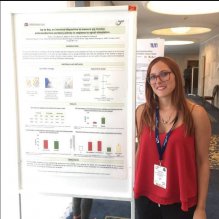Iris Gines presented her work at the 14th NuGOweek in Bulgaria
General -
AP-TO-BAS, AN INTESTINAL DISPOSITIVE TO MEASURE PIG MUCOSA ENTEROENDOCRINE SECRETORY ACTIVITY IN RESPONSE TO APICAL STIMULATION
Abstract
The enteroendocrine system helps to coordinate the processes occurring at the gastrointestinal (GI) tract and the functionality of the whole organism. However, the low abundance and scattered distribution of the enteroendocrine cells makes the study of the mechanisms underlying their function difficult. To overcome the ethical limitations of animal studies and the limitations of the available cell lines, ex vivo approaches seem to be the most simplified physiological alternative. In its turn, ex vivo models, such as Ussing Chambers still have the drawback of the limited number of samples that can be analyzed or the number of cells in each section. Here we provide an ex vivo system to assay vectorial transepithelial processes without the main limitations of the Ussing Chambers methodology.
We worked with different segments of the GI wall of a pig, from which muscular layers were removed, and mounted it in a dispositive that we called "Ap-to-Bas". We glued the samples to a silicon tube and placed it inside of a cell culture insert without bottom membrane. This allowed us to work with plenty of replicates of each intestinal segment. Tissue viability was checked by measuring lactate dehydrogenase activity in culture media, which after 60 minutes was negligible. The efficiency of the gluing process was evaluated using a 70-kDa fluorescein isothionate (FITC)-dextran. Barrier properties, measured by the crossing of Lucifer Yellow from apical to basolateral side, were maintained similar as in segments mounted in Ussing Chambers. Finally, to check the enteroendocrine functionality, tissues were apically treated with a Grape Seed Proanthocyanidin Extract (GSPE) and basolateral enterohormone secretions were measured. GSPE modulated entehormone (acyl-ghrelin, PYY and CCK) secretion at the duodenum. It also stimulated the secretion of total GLP-1 in the right colon. In conclusion, the Ap-to-Bas dispositive allows performing entoerohormone studies while keeping the apical and basolateral zones of the intestine separated.

